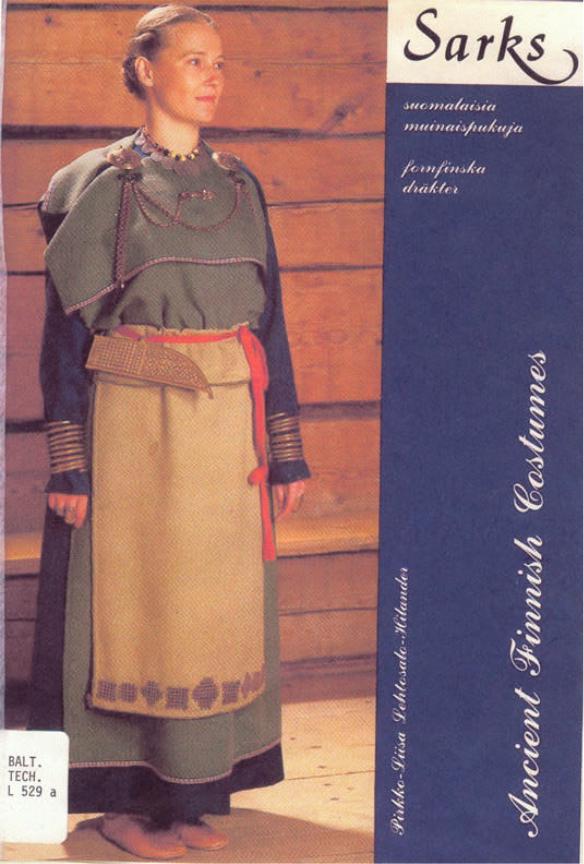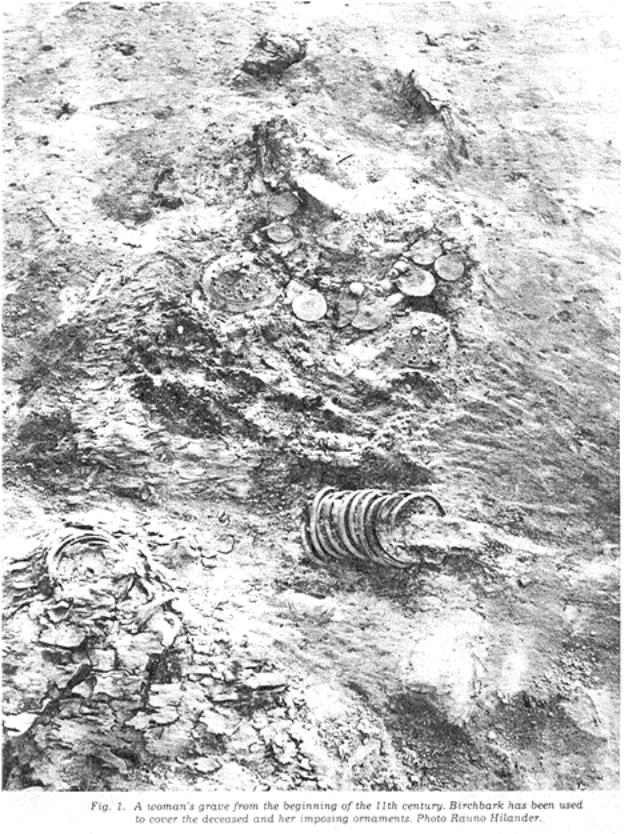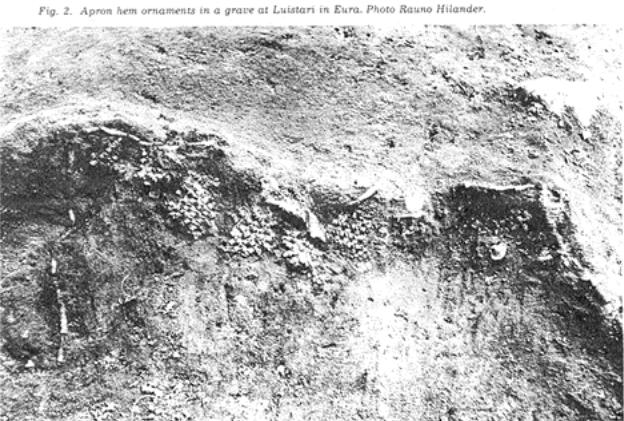
- •From Grave Finds to Reconstructions
- •Finnish inhumation cemeteries
- •Fabrics and materials
- •Sketches and Adaptations
- •The first pictures of ancient Finnish costumes
- •Ancient costumes on the stage
- •What the scientist said
- •Reconstructions for Exhibition and for Use
- •The Perniö costume
- •The first dress
- •The splendid spiral decoration
- •The Tuukkala costume
- •A dress for use
- •The Kaukola costume
- •A confusing interlude
- •Results of textile and colour analyses
- •The final reconstruction of the Eura costume
- •Development of fashion in other parts of Finland
- •Western traits in the east
- •The origin of Finnish spiral ornamentation
- •Pan-European trends of fashion?
- •Select bibliography

Contents |
|
FROM FINDS TO RECONSTRUCTIONS |
|
Finnish inhumation cemeteries ...................................................................................................................................... |
2 |
Textile finds and dresses................................................................................................................................................ |
4 |
Excavations in the field and in laboratories ................................................................................................................... |
5 |
Colours under the microscope ....................................................................................................................................... |
7 |
Fabrics and materials ..................................................................................................................................................... |
8 |
From details to dress ...................................................................................................................................................... |
9 |
SKETCHES AND ADAPTATIONS |
|
The first pictures of ancient Finnish costumes............................................................................................................. |
10 |
The sketches of the costumes from Tuukkala .............................................................................................................. |
13 |
Ancient costumes on the stage ..................................................................................................................................... |
14 |
What the scientist said ................................................................................................................................................. |
16 |
Aino costume ............................................................................................................................................................... |
19 |
Hjalmar Appelgren-Kivalo's book and the first »Eura costumes» ............................................................................... |
19 |
RECONSTRUCTIONS FOR EXHIBITION AND FOR USE |
|
The Pernio costume ..................................................................................................................................................... |
22 |
The Tuukkala costume................................................................................................................................................. |
28 |
The new costumes made according to finds from Ladoga Karelia .............................................................................. |
33 |
The Eura costume ........................................................................................................................................................ |
45 |
UNIFORM AND DISSIMILAR FASHION |
|
Women's costume and its ornaments in western Finland during the late Iron Age ..................................................... |
54 |
Development of fashion in other parts of Finland ....................................................................................................... |
56 |
Basic structure of costumes in Northern Europe.......................................................................................................... |
59 |
The origin of Finnish spiral ornamentation.................................................................................................................. |
60 |
Real or imagined schools of decoration....................................................................................................................... |
61 |
Pan-European trends of fashion ................................................................................................................................... |
62 |
Select bibliography ...................................................................................................................................................... |
64 |
Suomenkielinen lyhennelma - Resume pa svenska ..................................................................................................... |
65 |
THE MOST RECENT RECONSTRUCTION: The Masku costume .......................................................................... |
77 |
Illustrations: |
|
Rauno Hilander |
|
Pirkko-Liisa Lehtosalo-Hilander |
|
National Board of Antiquities of Finland, Archive for Prints and Photographs (NBA) |
|
Kalevala Koru Limited |
|
English language checked by Philip Binham, M.A. |
|
Karjalaisen Kulttuurin Edistämissäätiö and |
|
A. Ahlström Osakeyhtiö Company hade provided financial support for the publishing of this book |
|
Design and (c) Pirkko-Liisa Lehtosalo-Hilander |
|
Published by Suomen arkeologinen seura - The Finnish Archaeological Society, |
|
Box 913, 00101 Helsinki, Finland |
|
Printed by Vammalan Kirjapaino Oy, Vammala, 1984 |
|
ISBN 951-99605-4-6 |
|

ANCIENT FINNISH
COSTUMES
by Pirkko-Liisa Lehtosalo-Hilander
This is the story of Finnish ancient dresses, of dress fragments found in graves and of costumes made according to them. These costumes have become the festal garments of many Finnish women, but only few know the history of them.
These dresses are not national costumes although they have often been confused with them. National costumes are copied or constructed according to the peasant dresses of the 18th and 19th centuries. The costumes we are studying now are more or less scientific reconstructions of much older garments deriving from the Viking Age and centuries following.
Their story, however, is closely linked with the history of Finnish national costumes, and also with that of »Kalevala», the Finnish national epic. Therefore there is every reason to tell it now, on the eve of the 150th anniversary of »Kalevala».
From Grave Finds to Reconstructions
Finnish inhumation cemeteries
There are almost no pictures of Iron Age costumes in Finland. Accordingly only grave finds can tell us how the Finns were dressed in prehistoric times. However, during nearly all of the Bronze and Iron Ages, cremation was the prevailing form of burial in Finland, and therefore the first information we can obtain from graves is from a fairly late phase of the Iron Age. Certainly, the oldest known textile remains are from the 4th century A.D., but they are only small fragments fastened on a spearhead found in the Kärsämäki cemetery in Turku. It is not possible to make any reconstructions based on them.
About the year 600 A.D. inhumation burial became usual in Eura and Köyliö in Satakunta. At |
Fig. 1 |
the end of the 8th century this practice had extended to Yläne in northern Finland Proper, and it |
|
spread also to the other neighbouring areas, but only sporadically. In Eura, Köyliö and Yläne, |
|
however, the inhumation cemeteries were in continued use until the end of the heathen era. |
|
Accordingly it is mostly from these parishes round Pyhäjärvi that we can get information about |
|
dresses and their materials during the Merovingian and Viking periods. |
|
From the 11th century onwards there are inhumation graves also from other parishes in |
|
southwestern Finland, and from the next century there is also material from eastern Finland, from |
|
Savo and Karelia. The dress fragments found in these graves are also important from the pan- |
|
European point of view, because there are furnished graves as late as these only from a very few |
|
areas in Europe and there are no costumes from that time in any private or museum collections. |
|
Dress details have mostly been preserved in Finland because some garments have been |
|
ornamented with small bronze spiral tubes sewn on to the fabrics. These spiral ornaments have |
|
often been preserved, and their oxides have also conserved textiles. The spiral ornamentation is |
|
richest in the garments found in the youngest graves, and therefore our knowledge about the |
|
costumes of the 11th, 12th and 13th centuries is most abundant. Finds like those from Yliskylä in |
|
Perniö and Ristinpelto in Lieto, where textile fragments more than one metre long have been |
|
preserved, are very unusual, however. In general only after a careful excavation, a detailed |
|
documentation and many laboratory examinations can we get enough information about the |
|
connections of the ornaments and spiral decorations. |
|
The deceased have not always been dressed like living people. Sometimes the dead women have |
|
been covered with their big mantles or they can have been wrapped up in them, although they |
|
have otherwise been dressed in their best garments. The men on the other hand seem often to |
|
have had the mantle on their shoulders just as it could have been worn. But although there were |
|
many details in graves and they were in their proper places, it is a long way from the finding of |
|
an inhumation grave to a reconstructed dress. |
|
2

3

Textile finds and dresses
The problems involved with textiles and other organic substances already begin to appear while excavating. The textile remains are seldom well-preserved, because the graves are generally shallow, about 40 to 100 centimetres deep, and the fine sand - and still less the gravel - in which the graves have most frequently been dug is by no means favourable soil for the preservation of organic substances. On the other hand, the custom of ornamenting clothes with small twisted spirals of bronze and using heavy bronze ornaments has helped preservation. Accordingly the best details have been preserved in graves with abundant furnishings.
The spiral decorations are often the only parts of clothes left. In women's mantles, only the |
Fig. 2 |
trimming has been preserved, in aprons the hems, and in veils the rows of rings round the face. |
|
There are not many remains of under garments or dresses. There might be small textile fragments |
|
in connection with brooches and other ornaments of dress, but skirts and gowns have usually not |
|
been ornamented with 'spirals, and therefore they have not so often been preserved. Shirts and |
|
under garments have mostly disintegrated, especially linen ones, because linen suffers more from |
|
soil acids than wool. |
|
According to digging observations, the under garments have also often been of wool. It is |
|
however possible that in these instances too the deceased might have had a linen shirt nearest his |
|
skin. Not all details have been preserved, and often |
|
4
only the textiles directly under or over bronze ornaments are identifiable. Thus there could have been more than we can observe now.
Spirals were used less in men's clothes, and therefore there are fewer remains of them. In some graves in Eura and Köyliö there have been men's belts and garters with spiral platings. Men's cloaks have also been ornamented with applicated spiral stars and with ornaments extending from the corners or edges of the mantle. Thus it has been possible to reconstruct some details of the male costume also.
Fig. 3 There are also children's graves in the Finnish cemeteries, and some of them have been abundantly furnished. Thus we know that sometimes the children have been adorned with miniature-sized ornaments. It seems that little girls could have had garments similar to those used by women, although there are no remains of aprons and veils in children's graves. Shirt, dress and mantle have been sufficient for little girls.
The little boys have been given a miniature spearhead or an axe, and there are sometimes details of belts and mantle brooches or ornamental pins. Textile remains are however few. There is nothing from Finland like the spiral-ornamented tunic found in a Livonian boy's grave at Salaspils Laukskola in Latvia. Just as in men's garments there has not been abundant metal ornamentation in their costumes. This does not mean that these garments have not been decorated. They may have had colourful bands and ornamental borders, which have not been preserved.
Excavations in the field and in laboratories
Textiles a thousand years or more old are very brittle. Nor have the small bronze spirals always preserved their structure during the centuries. Even in some instances the cords have been preserved and the spirals have disappeared. And they can disintegrate very soon after the excavations. Therefore it is very necessary to chart and photograph various details at the excavation stage.
There are however certain risks in trying to throw light upon all details during the excavations. The varying of conditions, a change from damp cool sand to the air at a temperature of perhaps 30 degrees Centigrade, will not fail to leave traces on objects and fabrics. Rust cracks off in flakes from iron objects, birchbark and leather curl up, textiles crumble in the hands. In no more than the time it takes to make a drawing and take a photograph, objects may disintegrate.
This happened, for instance, to the large bronze-coated knife sheath found in the Luistari grave according to which the Eura costume is reconstructed. The sheath was dug up almost undamaged, and was photographed along with other objects from the grave, but before it could be transferred to a box for transportation, the leather below the bronze plating began to curl up. This caused the thin bronze plate, which had become very brittle, to disintegrate, so that nothing but fragments was left. Fortunately the photographs had come off well; the details could be studied in them.
To avoid situations like this, various methods of transporting graves or parts of them packed in some kind of adhesive substance have been developed. The final excavation is performed in the museum after the grave has first been studied by X-raying. Every detail is drawn on maps and studied in microscopes before the lumps of organic material are parted from metals. It is most fortunate, although not
5

always possible, if this kind of "excavation" in the museum is performed by a team of textile experts, laboratory personnel, archeologists, draughtsmen and photographers.
The conservator's biggest problem is how to handle the combinations of many different materials. Bronze spirals sewn on to various pieces of clothing or with threads through them are met with in almost all investigations of inhumation graves. Pieces of cloth preserved on or under bronze ornaments and rusted fast to the surfaces of iron objects are not uncommon either. Leather has often been preserved together with bronze-plated knife sheaths, belts and purses, and sometimes one may find remains of skins spread beneath the dead persons. Brocade ribbons and silver braids are more rare, but they are found every now and again. The conservator wants to separate the different materials for the proper treatment, but this cannot be done without careful documentation.
6
The textile expert may be quite content if he observes the composition of a rare fabric, or a tablet-woven band with an unusual weft. The archeologist wishes to know whether this fabric was the cover for a body or whether the body was dressed in it. The things the historian of dress is interested in are again different. He wants to know whether the warp may run across the body, and whether the unusual band was stitched on to the edge of the fabric or was separate from it. Even very small pieces of fabric may help him to reconstruct the whole, if he gets correct information about them.
Colours under the microscope
The structure of fabrics can be detected from little bits, too, and it is possible to find out the original colours of the fibres to some extent by microscopic studies. Some colouring matters used like indigo can be detected by chemical analyses, but most of the vegetable dyes are as yet impossible to distinguish with chemical methods. Therefore the microscopic observations are very important in defining colours. Also our knowledge about dyes formerly used by country women is of use, likewise the fact that interest in dyeing with vegetable matters is increasing in Finland. So we can compare the old fibres with the new ones dyed with known matters.
Unfortunately, the colours have changed in the earth during the many hundred years gone by. Bright scarlet and deep-blue are, however, easily distinguishable from others. In addition, there are also textile finds in which different tints can clearly be seen. For instance from Tuukkala in Mikkeli (Savo) there are cloth fragments with brownish basic tone and red, blue and yellow stripes. Thus we know that strong colours have also been used.
It is possible that the threads for tablet-woven bands and other ribbons were most often dyed. With them one could get a colourful impression although the garments would have been of natural colours, white, grey or blackish brown. It is however worth remembering that there are many plants in Finland which were used in dyeing before the aniline colours were invented, and it is not difficult to get them or use them in dyeing. Nettles and spruce twings for greens, birch leaves, heather and lycopodium for yellows, moss and lichen for browns and hazels, many different kinds of Galium species for brick red and orange yellows can be found everywhere. And it is known that still during the last century woad (Isatis tinctoria) was cultivated in Finland to get blue. Now it is almost extinct; it only grows wild in some places on the Finnish coast.
The dyeing substance in Isatis tinctoria is the same as in the indigo plant, although much weaker. Therefore it is not possible to say whether the dyeing has been done with woad or with indigo. Probably the colouring matter used in the northern countries in ancient times was woad, because its seeds have been found from the Oseberg ship burial in Norway. It is also known that Charlemagne had woad and madder fields sowed in his domains, and later on these plants were widely cultivated in Western Europe.
According to present finds we could assume that blue was a very popular colour among the Finns. However, this can be a misconception. When textiles have been preserved only in graves with ample furniture, blue can be the colour especially favoured by the rich and only used by them. Are then the clothes dyed blue
7
